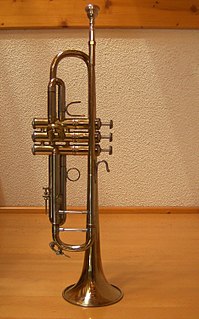A piano trio is a group of piano and two other instruments, usually a violin and a cello, or a piece of music written for such a group. It is one of the most common forms found in classical chamber music. The term can also refer to a group of musicians who regularly play this repertoire together; for a number of well-known piano trios, see below.
A piano sextet is a composition for piano and five other musical instruments, or a group of six musicians who perform such works. There is no standard grouping of instruments with that name, and compared to the string quartet or piano quintet literature, relatively few such compositions exist. The best-known piano sextet is probably the Sextet by Poulenc, one of the pinnacles of the wind and piano repertoire. Chausson's Concert is widely regarded as one of the masterpieces of French strings and piano chamber music literature.
John Harris Harbison is an American composer, known for his symphonies, operas, and large choral works.
Flute repertoire is the general term for pieces composed for flute. The following lists are not intended to be complete, but rather to present a representative sampling of the most commonly played and well-known works in the genre. The lists also do not generally include works originally written for other instruments and subsequently transcribed, adapted, or arranged for flute, unless such piece is very common in the repertory, in which case it is listed with its original instrumentation noted.
Concertino is the diminutive of concerto, thus literally a small or short concerto.
In music, a nonet is a composition which requires nine musicians for a performance, or a musical group that consists of nine people. The standard nonet scoring is for wind quintet, violin, viola, cello, and contrabass, though other combinations are also found.
Among the fairly large repertoire for the standard piano trio are the following works:
A clarinet-cello-piano trio is a clarinet trio made up of one clarinet, one cello, and one piano, or the name of a piece written for such a group.
The Melos Ensemble is a group of musicians who started in 1950 in London to play chamber music in mixed instrumentation of string instruments, wind instruments and others. Benjamin Britten composed the chamber music for his War Requiem for the Melos Ensemble and conducted the group in the first performance in Coventry.

The trumpet repertoire consists of solo literature and orchestral or, more commonly, band parts written for the trumpet. Tracings its origins to 1500 BC, the trumpet is a musical instrument with the highest register in the brass family.
Marc-André Dalbavie is a French composer. He had his first music lessons at age 6. He attended the Conservatoire de Paris, where he studied composition with Marius Constant and orchestration with Pierre Boulez. In 1985 he joined the research department of IRCAM where he studied digital synthesis, computer assisted composition and spectral analysis. In the early 1990s he moved to Berlin. Currently he lives in the town of St. Cyprien and teaches orchestration at Conservatoire National Supérieur de Musique de Paris.

Marcello Abbado was an Italian pianist, composer, conductor and academic teacher. His compositions include several orchestral works, two ballets, numerous pieces for solo piano, and chamber music. As a pianist, he played in major concert halls of the world. He taught composition at several conservatories, ultimately at the Giuseppe Verdi Conservatory. In 1989 he was awarded the Gold Medal for Meritorious Culture and Art by the Government of Italy.
Igor Zubkovsky is a Russian cellist.
Graeme Peter Crump, known professionally as Peter Graeme and as 'Timmy' Crump to friends and family, was an English oboist and academic teacher. He was best known as the principal oboist of the Melos Ensemble.

The Poulenc Trio is an American chamber music ensemble and oboe-bassoon-piano trio, formed in 2003. The current members are pianist Irina Kaplan Lande, bassoonist Bryan Young and oboist Alexander Vvedenskiy. Former members have included New York Philharmonic principal oboist Liang Wang, Orpheus Chamber Orchestra oboist James Austin Smith and Vladimir Lande. Wang joined the group in 2015 after the departure of the founding oboist Vladimir Lande.
The Trio pour hautbois, basson et piano, FP 43, by Francis Poulenc is a three-movement chamber work, composed between 1924 and 1926, and premiered in the latter year.
Aubade, a choreographic concerto for piano and 18 instruments, is a work of Francis Poulenc premiered in 1929. It was conceived as a ballet, but is more often played as a chamber piano concerto.
The bassoon repertoire consists of pieces of music composed for bassoon as a principal instrument that may be performed with or without other instruments. Below is a non-exhaustive list of major works for the bassoon.



